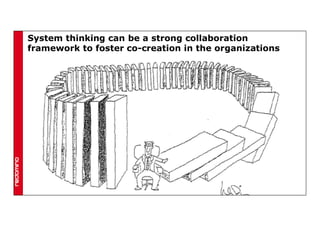Cultivating communities of practice at International Labour Organization
- 1. Cultivating Communities of Practice at International Labour Organization ITCILO – Torino 14.11.2013 Flavio Fabiani – [email protected]
- 2. ILO ACIs – complex and interwoven subjects No matter how you define or describe your areas of critical importance, there can be little doubt that it are a complex and interwoven subjects
- 4. Everybody says, we need to collaborate more to be able to handle highly complex, dynamic systems But what we keep saying does not necessarily happen and indeed it didn’t happen in the past in many cases
- 5. How to develop a collaboration network?
- 6. System thinking can be a strong collaboration framework to foster co-creation in the organizations
- 7. To achieve system thinking we need to shift the systems where we are: i.e. transform the relations among players in those systems When we meet we need to use time as precious resource, not just looking PowerPoint presentation.
- 8. We should engage in conversations: it is not easy to come all together and meet in person nowadays so we need to use this time to know each other and mutually understand us
- 9. Having reflective conversations is an essential condition to transform the relations in the system and a great opportunity to build trust We all know that when there is no trust in teams they don’t work, the same happen in larger networked virtual teams
- 10. What all these images have in common? VULNERABILITY MUTUALITY
- 11. Misconception of vulnerability The journey of building trust is never ending and requires openness and disclosure. Vulnerability is the soil nutrient, here human beings grow trusting relationships and here is where we have problems We cannot manufacture mutuality we need to grow it through a different quality of the conversations, where people can talk honestly to each other and ask for help.
- 12. you don’t build a collaboration network from a bunch of people who don’t need each other, do you? When people from different organizations get together they put on this good faces and start talking about the great things they do: everybody goes in sales mode
- 13. TRANSFORMING THE RELATIONS 1 2 So first thing we could do is engage ourselves in reflective conversations to mutually understand each other, avoiding to go in sales mode During this conversations we should talk also about our difficulties in order to start supporting each other (mutuality) If we do this honestly we build trust which is a conditio sine qua non for effective collaboration while going through this process we should continually be looking for opportunities where people can collectively start to see the larger system
- 14. What motivates people at the very beginning is to see that there really is a larger system and they are all part of this larger drama (sensing the system) People from different institutional perspectives travel together and physically go and see a part of the system
- 15. After sensing the system a good practice is to develop a map to understand how the different pieces fit together
- 17. TRANSFORMING THE RELATIONS 1 2 So first thing we need to do is engage ourselves in reflective conversations to mutually understand each other, avoiding to go in sales mode During this conversations we should talk also about our difficulties in order to mutually support each other If we do this honestly we build trust which is a conditio sine qua non for effective collaboration while going throgh this process we should continually looking for opportunities where people can collectively start to see the larger system
- 18. SENSING THE SYSTEM 2 3 collectively start to see the larger system. learning journeys: people from different institutional perspectives travel together and physically go and see a part of the system collective system mapping helps to identify the main overall objective of the networked team and what is critical to achieve it co-create by genuinely share visions, which is usually happening well down the road
- 19. Case: Re-amp
- 20. Case: Sustainable Food Lab
- 21. role playing
- 22. Vision clarification exercise Phase 1: 5 mins thinking A is standing and voices, undisturbed, his vision to B/C/D B listen to the content (is it clear?) C listen to the feelings expressed (is it touching?) D listen to the direction of the will (has it concrete steps?) Phase 2: max 10 mins feeling willing After 5 mins B,C,D talk about A’s vision presentation A listen and takes notes during the group discussion of B, C and D B/C/D give A tips on how it can be done better (3 tips thinking, feeling willing) Phase 3: max 5 min A gives a second presentation based on the tips B,C,D tell A what impact it had on them now
- 23. The core principle underlying the transformation towards a cocreation strategy aiming at generating a cocreative mutual value is: engaging people to create valuable experiences together while enhancing network economics
- 24. increases efficiency by cutting costs expanding the space of • reduce marketing budget necessary to valuable launch products / services experience • avoiding launch of products / services not allows individuals to gain new experience of value valued by the customers enhance enterprises strategic capital EXPERIENCE MIND-SET expanding the scope and expanding stakeholders relationships NETWORK RELATIONSHIPS ENTERPRISE ORGANIZATION the scale of INDIVIDUALS INTERACTIONS interactions among people who are in our ecosystem part of our It lower employees turnover ENGAGEMENT PLATFORMS It expands market opportunities reduces business risks • by increasing insights generation • by pre-testing investments decreases risks and cost for individuals expanding the linkages among our co-creation platform and the other engagement platforms used in our ecosystem ecosystem
- 25. Designing processes Traditional representations of a business process is a left-to-right arrow where successive process owners optimize their process steps in order to deliver the best value to the next operator in the value chain The traditional approach to business process design start with the definition of the process and attempt to deliver efficiently and predictably. Continuous improvements methodologies (e.g. six sigma) are important in this scenario and parameters like cycle time reduction, cost reduction, minimization of output variations are important.
- 26. Designing for stakeholders‘ interaction/engagement If we start looking at operations with a co-creation approach in mind, soon we realize that the difference of process owner and process customer is irrelevant Business processes shouldn’t only be driven by the process owner (left-to-right) but also by the process customers (right-to-left) INDIVIDUALS Process customers (individuals) don’t want their needs to be frozen at the beginning of the process design investigation, they want a real time adaptation of their process needs. Process customers empowered by technology want to engage in the process on their terms and require that the organization adapt the contexts every time they interact Process design focus is therefore not only on the desired outcome, but more and more on the platform of interaction and engagement that will allow process owners and process customers to come together in each new interaction context
- 27. Why should we be limited by the intrateam competencies? co-creation platforms could provide access to greater competencies through a welldeveloped global resource base Within organization, one big challenge is to push managers out of their comfort zones and into the zone of new opportunities
- 29. Push managers out of their comfort zone Over the decade, the Internet and other engagement platforms where stakeholders from around the world can interact to contribute their insights and experience to the design of products and services are changing the economics of innovation. Committed process customers / consumers want to influence how they will be served and therefore want to be involved in the activities typically thought of as internal to the organization, such as access to resources and the value creation process. Thus the process of value creation shifts away from a firm-and-product-centric approach to a stakeholding-individual and experience-basedcompetence perspective. The game changer is that the sources of competence available to managers now have expanded to include the collective intelligence
- 30. Engage and discover Advances in information access and connectivity through the application of network technology, exponentially increase a corporation’s ability to utilize the skills, interests and knowledge of customers as resources. Managers should be considered any employee, at any level, who has the ability to directly influence the consumer experience and facilitate co-creation. To do this, companies need to build IT flexible infrastructures so that line managers throughout the organization can access and activate the right resources and knowledge at the right time. IT systems must also be more “event-based” so that all line managers are constantly tuned into context-rich customer information.
- 31. user journey through the co-creation design
- 32. user journey through the co-creation design


































